Each of the founding departments have long and venerable histories in scientific
computing, and themselves have resulted from many mergers over the preceeding years.
Below is a brief overview of the history of the departments which have come together
to form the current CCLRC Department for Information and Computation.
|
Departmental history at the Atlas Computer Laboratory |

|
During the 1950's the scientific computing needs of the UK were dominated by nuclear research with Aldermaston
as the dominant computer centre initially running a Ferranti Mark 1 machine, later supplemented by
an IBM 704 and an IBM 7090 in 1958; Harwell ran Relay machines and acquired a Mercury 1401 in 1958.
Outside the AEA were an Elliott 803 at Reading, Ferranti Mercuries at Oxford, London and Manchester,
and an EDSA at Cambridge.
In August 1961 the first Atlas computer was ordered by the National
Institute for Research in Nuclear Science (NIRNS) to be housed in a new laboratory
with usage allocated as follows: Harwell 20 hrs/week; Culham 10hrs/week; NIRNS 15hrs/week; Met. Office
2.5 hrs/week and all universities 25 hrs/week since no university believed it could use more
than 5 hours/week. It was the supercomputer of the day and had not only paged virtual
memory but also an operating system with device independence and other features commonplace today.
The ICL Atlas computer was installed in May 1964 in the newly established Atlas Computer Laboratory.
|

|
By 1965 it was clear that the Atlas centre could not meet the computing demands of the nuclear research
community, and it continued to support universities while they purchased further machines.
Many foundational computing developments were undertaken at the laboratory in areas including databases,
AI, user interfaces, weather forecasting, satellite data processing, quantum chemistry,
finite element analysis, crystallography, concordance creation, archaeology and graphics.
As an example, among the
early graphics developments
was the production
of animated films, the best known was on FE which still looks good today. The facilities were later used by
Software Simulation Ltd for commercial production including the generation of the first animated logo for
Channel 4 television.
|
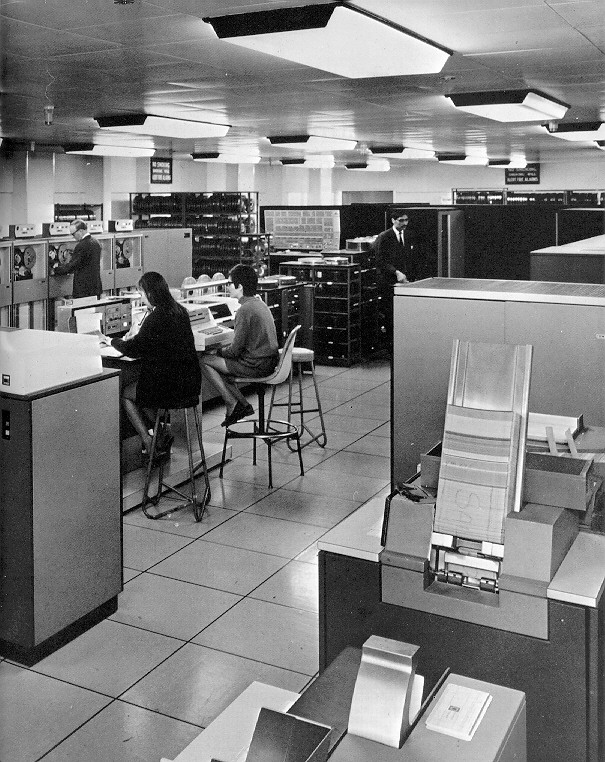
|
In 1971 an ICL 1906A was installed with twice the computing power of the Atlas 1 which
was withdrawn from service after seven years. However, this still left the laboratory with only
a fraction of the computing power available at the Rutherford Laboratory, London or Manchester.
In 1975 the Atlas Laboratory was merged with the adjacent Rutherford High Energy Physics Laboratory
with many of its computational support activities moving to the Daresbury Laboratory.
|
|
Departmental history at the Rutherford Appleton Laboratory |

|
The Rutherford High Energy Physics Laboratory was founded by NIRNS receiving its Royal Charter on 23rd June 1958.
The first computer installed at the Rutherford High Energy Physics Laboratory in 1962 was a Ferranti Orion.
In 1967 the Ferranti Orion was replaced by an IBM 360/75. These computers were used mainly for particle physics
data processing and simulation, and particularly for reconstructing events recorded in bubble chambers.
|

|
In 1969 a pen control on an IDI graphic display was used to patch up bubble chamber track results where pattern
recognition errors were generated by superfluous tracks close together. By 1972 twelve private data lines for
remote job entry were linked to the Rutherford Laboratory from UK universities and CERN.
|

|
In 1975 the Atlas Laboratory was merged with the adjacent Rutherford High Energy Laboratory creating the Rutherford Laboratory
and the two computing departments (the Atlas Computing Division and the Computing and Automation Division of the Rutherford Laboratory)
merged into one located in the Atlas Centre. A private network (the SRC intranet) was established linking the 360/195 at
Rutherford with the 370/165 at Daresbury and the ICL 1906A on the Atlas site. The network links were
extended in 1975 to connect through UCL to the ARPAnet of 65 US sites to establish the Internet.
|
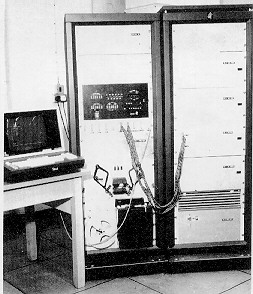
|
In 1977 the Interactive Computing Facility was established to enhance interactive computing for engineering research
workers and designers. The ICF had 3 networks. DECnet connecting the DEC systems to some PDP11s. A PRIME proprietary
network between all the PRIMEs and a third between GEC machines. The fourth network was IBM based connecting the IBM systems to
many 2050 Remote Job Entry stations throughout the UK. They were all interconnected and eventually merged to create SRCnet.
In 1978 the Distributed Systems Programme was established to examine architectures and programming languages for
distributed systems. One project involved the 16-processor CYBA-M machine at UMIST.
|
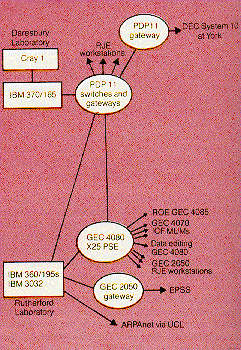
|
In 1979 the Rutherford Laboratory merged with the Appleton Laboratory to form the single Rutherford Appleton Laboratory.
An ICL 2960 was installed at the Atlas centre following the merger, with 1Mb of main memory,
four 9-track tape decks and four 200Mb disc drives. The Appleton Laboratory
ICL 1904S and GEC 4070 which were used for satellite support were phased out
as staff moved into the Chilton site.
Following these mergers, the central computing servers at the Atlas Centre continued to
grow so that in 1979 an IBM3020 was introduced to act as a front end to two IBM 360/195
processors in the growing laboratory, later replaced by an IBM 3032. In 1982 an IBM 3081D replaced one of the
360/195 processors in this central configuration. This configuration was joined
by an ICL Atlas 10 in 1983.
|
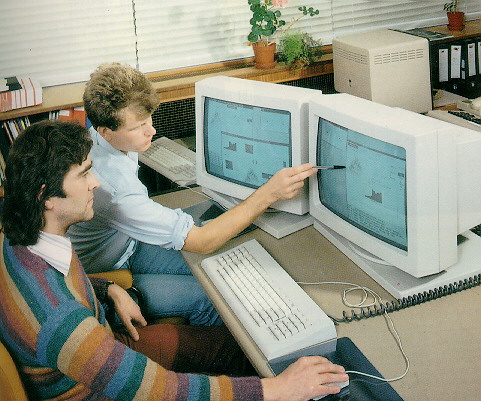
|
In 1984 this Department had grown to a large size, and it was split into the Central Computing Department
handling the main service provision and the Informatics Department handling engineering and advanced
interactive applications. An example of these was the MUSK collaborative computing tool allowing workstation
users to share information on screen.
|
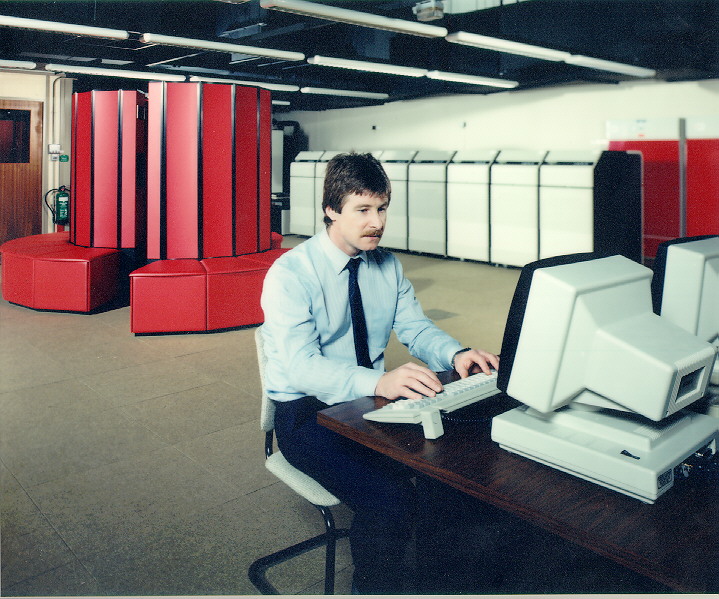
|
In 1987 a Cray X-MP/48 was brought into service in the Atlas Centre, which was then
replaced by a Cray Y-MP81/8128 in 1992 to meet the growing demand by the
UK science community for high performance computing power. In 1992 this was
also joined by a DEC 7000 system, and a group of OSF/1 (5 DEC 3000's) and CSF
(a farm of HP RISC machines) computer farms. In 1988 the old Atlas 10 and
IBM 3081D were replaced by an IBM 3090-200E which acted as a front end to the Cray.
This was upgraded in 1989 to a 400E and then a 600E before it was finally
withdrawn in 1995. In March 1996 the Cray Y-MP was in turn replaced by a 32-processor
Cray J90. The first departmental WWW server was established in May 1993,
and more recent projects and developments are documented elsewhere on this server.
|

|
SRCnet became JANET, and then SuperJANET was developed after 1989 with bandwidth to support
ATM (Asynchronous Transfer Mode) network with access at 155 Mbps. One function of
SuperJANET is to support high quality video connectivity, allowing real time video
conferencing from the desktop concurrent with scientific work, or the transport of
supercomputer output in the form of video generated through the Atlas Video Facility
continuing the tradition of animation generation in the department. In April 1994 the
company UKERNA was created and the management of the JANET network passed to it.
|
|
In November 1994 the two RAL departments were merged to form the Computing and
Information Systems Department, thus combining their strengths and avoiding
duplication of function. In June 1996 the RAL CISD department was merged with
the Daresbury Theory and Computational Science Department to form the federal
CCLRC Department for Computation and Information.
|
|
Departmental history at the Daresbury Laboratory |
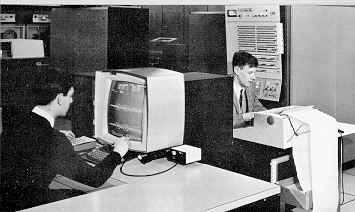
|
The first large computer at Daresbury was an IBM 360/50, installed in 1966.
By 1968 the Computing Group at the Daresbury Laboratory was concerned with the provision and operation
of a central computing service, the development of film analysis facilities, the implementation,
in conjunction with the electronics group, of on-line links and terminals and with a
programming service. The 360/50, which ran the MFT operating system was replaced in November 1968 by a
360/65 running the MVT multi-programming operating system. An IBM 2250 graphics terminal, an IBM 2740
communications teletype and an IBM 2314 disk store were also used along with 100m network
links to two PDP8 computers. The IBM 2250 display system was used to analyse beam transport problems.
|
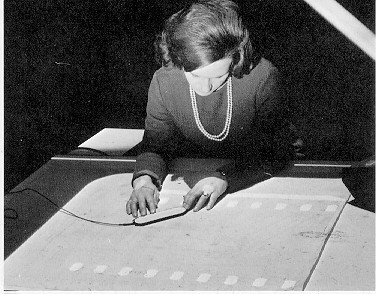
|
In 1971 network links expanded outside Daresbury with a 35km microwave video link
to the GPO/TV station at Winter Hill using one of several CAMAC systems.
A Vanguard film plane digitiser which was connected on-line to the central
computer was used to scan and measure film taken during experiments on the
production of particles by a tagged photon beam.
|
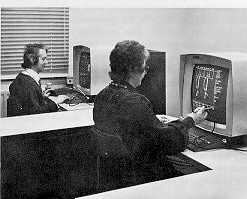
|
In 1973 an IBM 370/165 replaced the IBM 360/65 including 2Mbytes of core memory and 850 Mbytes
of direct access disk storage supporting twelve 2741 typewriter terminals and a new network
link to the Manchester experimental area. By 1974 IBM2250 displays were used as interactive
graphics displays for the Rutherford Laboratory's magnet design program GFUN.
During the mid-70's the Daresbury computer network became part of the SRC
Network which by 1978 linked the Daresbury and Rutherford central computing facilities
to Glasgow, Coleraine, Lancaster, Manchester, Liverpool, Sheffield, Bidston and York
directly from Daresbury, and other sites from Rutherford.
|

|
The Computational Science group supported the Collaborative Computational Projects (CCPs) to co-ordinate
the efforts of university departments in specialised areas of computational science. The
initial projects were in Electron Correlation in Molecular Wavefunctions, and Continuum States
of Atoms and Molecules, with the addition of Computational Studies of Surfaces in 1979. In October
1977 the Microdensitometer Service of the Chemistry Committee of the SRC was moved from
the Atlas Computer Laboratory to the Computational Science Group, mainly to scan
crystallographic film packs to determine crystal structure. This work resulted in the development
of large databases of structure information with supporting information retrieval facilities
in the Chemical Databank Service (CDS).
|
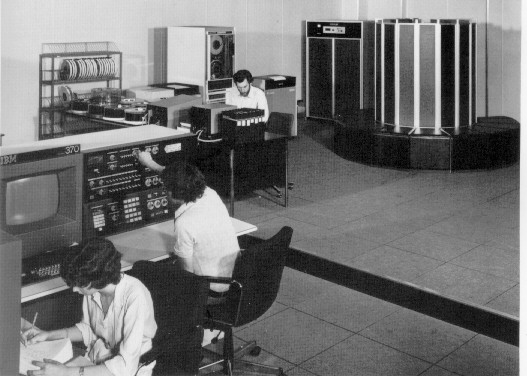
|
In spring 1979 the first Cray-1 was installed using the IBM 370/165 as a front end. The systems were
linked through the SRC computer network to the Rutherford Laboratory computer centre. The support
provided by the Cray allowed the number of Collaboratove Computational Projects to grow to eight by 1980.
By 1981 the Computational Science group had become the Theory and Computational Science Division
to provide support for the work undertaken at the Synchrotron Radiation Source (SRS) and the
Nuclear Structure Facility (NSF), whilst continuing support for the Collaboratove Computational Projects.
The Computing Service changed its CRAY-1 for a CRAY-1 S/500 which entered service in March 1981,
while the IBM 370/165 was replace by a National Advanced System's AS/7000 with 8Mbytes
main storage and 6Gbytes of on-line storage, and moving from the MVT to an MVS operating system.
|
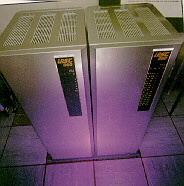
|
By 1990 developments had moved from mainframes towards parallel supercomputers, and an Intel iPSC/860
distributed memory machine was installed with 32 Intel i860 processors in the Advanced Research
Computing Group which could be applied to many kinds of scientific applications. In 1992 the
number of processors on the Intel iPSC/860 was doubled to 64 as demand for parallel supercomputing
grew further.
|

|
Also by 1990 the number of CCPs had grown to 11 of which 9 were supported at Daresbury, and the CDS database
supporting chemistry research had been joined by the SEQNET database of protein and nucleic acid sequences
to support biological science. In June 1996 the RAL CISD department was merged with
the Daresbury Theory and Computational Science Department to form the federal
CCLRC Department for Computation and Information.
|

